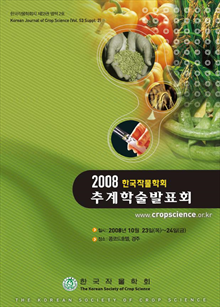간행물
한국작물학회 학술발표회 KCI 등재

- 발행기관 한국작물학회
- 자료유형 학술대회
- 간기 반년간
- 수록기간 2007 ~ 2010
- 주제분류 농수해양 > 농학 농수해양 분류의 다른 간행물
- 십진분류KDC 524DDC 633
권호리스트/논문검색
2007 한국작물학회 추계학술발표회 (2007년 11월) 62건
61.
2007.11
서비스 종료(열람 제한)
Objectives
The objective of our research was to establish the gene transformation, expression and characterization system in transgenic Codonopsis lanceolata.
Materials and methods
Agrobacterium tumefaciens strain LBA 4404/ binary vector pYBI121Regeneration of transgenic shoots: MS medium supplemented with 0.1 mg/ℓ NAA and 1 mg/ℓ BAP, 3% sucrose and 0.8% agar at pH 5.8. Agrobacterium cell density OD 600 between 0.8 and 1.0, Infection: 5 minutes DNA isolation and Polymerase chain reaction: DNA was extracted from young leafs excised from kanamycin resistant shoots. Two primers used for PCR amplification of the 700 bp of the npt II gene were N 1 (5′ GAA GCT ATT CGG CGG CTA TGA CTG 3′) as a sense primer and N 2 (5′ ATC GGG AGC GGC GGC GAT ACC CTA 3′) as a anti sense primer.
Result and Discussion
Adventitious shoots regenerated 3 weeks after Agrobacterium infection on regeneration medium
containing 0.1 mg/ℓ NAA and 1 mg/ℓ BAP, 100 mg/ℓ kanamycin 250 mg/ℓ cefatoxime.
Numerous adventitious shoot inductions of putative transformants were observed from the cut
surface of explants which initially resembled knob like structure and later developed into new
plant. PCR analysis of showed the expected bands of npt II gene. PCR analysis was carried out
to confirm the insertion of the npt II gene in the genome of transformed plant. The expected
amplified npt II fragments of size 700 bp was found in the T0 transformed plants, indicating the
integration of npt II gene.
62.
2007.11
서비스 종료(열람 제한)
Ok-Tae Kim, Kyong-Hwan Bang, Young-Chang Kim, Yu-Su Shin, Dong-Yun Hyun, Byong-Yel Yeon, Yeoung-Seuk Bae, Nak-Sul Seong, Seon-Woo Cha
Objectives
Here, we report the effect of overexpression of ginseng farnesyl diphosphate synthase on the transcription of three key regulatory enzymes involved in triterpene metabolism in hairy root of ginseng and Centella asiatica (L.) Urban.
Materials and Methods
A four-year-old root of Panax ginseng C.A. Meyer and Centella asiatica (L.) Urban whole plants were obtained from National Institute of Crop Science (Suwon, Korea) and Chonnam National University (Gwangju, Korea), respectively. Agrobacterium rhizogenes R1000 strain was kindly provided by Dr. In (Nongwoo Bio, Yeju, Korea).
Results and Discussion
The role of farnesyl diphosphate synthase (FPS) in triterpene biosynthesis (Fig. 1) was investigated. A pCAMBIA3101 vector was used to insert a exogenous gene into target plant genome (Fig. 2). After the transformation, we produced Panax ginseng and Centella asiatica hairy roots by introducing the coding region of the gene from Panax ginseng. In these hairy roots, integration of the transgenes into the C. asiatica nuclear genome was confirmed by PCR analysis using PgFPS (P. ginseng FPS) primers and by Southern hybridization using PgFPS-specific probe. FPS specific activity is increased 4-fold compared to controls. In RT-PCR analysis, overexpression of PgFPS in hairy roots was observed (Fig. 3) and two genes, cycloartenol and beta-amyrin synthase, related to triterpene biosynthesis were up-regulated. These results suggest that FPS overexpression might lead to an enhanced biosynthesis of triterpene saponins and phytosterols. However, we did not demonstrate whether or not the introduction of PgFPS gene in Centella asiatica genome directly enhances triterpene saponin production, although our results showed that gene expression related to triterpene saponin biosynthesis were obviously up-regulated. Therefore, additional experiments such as overexpression of FPS gene in triterpene saponin-deficient mutant plants will be required.

